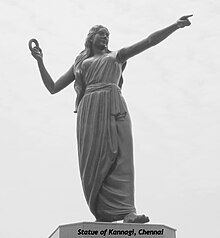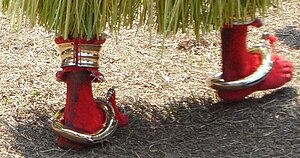Silambu
Silambu(Tamil:சிலம்பு;Malayalam:ചിലമ്പ്/cil’əmpɨ̆/), orGaggara(Tulu:ಗಗ್ಗರ), is anankletworn and used in a variety of contexts on the Indian subcontinent.
Etymology
[edit]According to Jeyaraj, the word 'silambu' is derived from the verb 'silambal', meaning 'to make sound'.[1]
Description
[edit]The silambu is a hollow anklet filled with beads that produce noise when the wearer moves or dances.[2]It may be worn on the ankle or the leg. When worn on the leg, it is termedkālchilambuin Tamil.[3]
Some varieties of silambu are made of copper and use iron balls to produce sound.[4]Others are made of silver.[5]
Importance
[edit]In dance
[edit]Nautchperformers wore silambu.[2]Kandyandancers may wear silambu.[4]
In art and literature
[edit]Shivain his dancing posenatarajasometimes wears a silambu on his ankle.[citation needed]

The epicSilappatikaramis structured around the character Kannaki's attempt to sell her silambu, and takes its title from the name of the anklet.[6][7]
In religion and rituals
[edit]Silambu are sometimes placed on cows' legs during thePongalfestival.[8]In Tamil Nadu, a traditional dance calledkai silambu aatamis performed in temples during Amman festivals in which the dancers wear or hold silambus in their hands, which make noise when shaken.[citation needed]
Silambu is also used in ritual dance performances of southern India, such as theTheyyamofMalabar regionand theButa KolaofTulu Naduregion.
See also
[edit]Notes
[edit]- ^Jeyaraj 1999,p. 39.
- ^abSambamoorthy 1976,p. 6.
- ^Sambamoorthy 1976,p. 23.
- ^abBanerji, Projesh (1959).The Folk-Dance of India.Allahabad: Kitabistan. pp. 189–190.
- ^Marcuse, Sibyl (1975)."Silambu".Musical Instruments: A Comprehensive Dictionary.New York:Norton.p. 476.ISBN9780393007589.
- ^Chakravarti, A. (1944).Jaina Literature in Tamil.New Delhi: Bhāratīya Jñāpītha. p. 51.
- ^The Śilappadikāram.Translated by Dikshitar, V. R. Ramachandra.Oxford University Press.1939. p. 1.
- ^Sambamoorthy 1976,p. 24.
Sources
[edit]- Jeyaraj, V. (1999)."Analysis of a Bronze Anklet from Kerala".Museum's Journal.Government Museum, Chennai.
- Sambamoorthy, P. (1976).Catalogue of Musical Instruments Exhibited in the Government Museum, Chennai.Chennai: Principal Commissioner of Museums,Government Museum.



